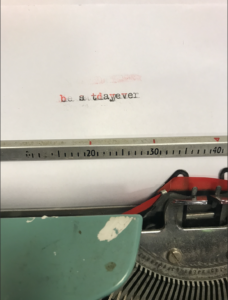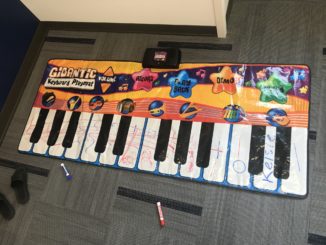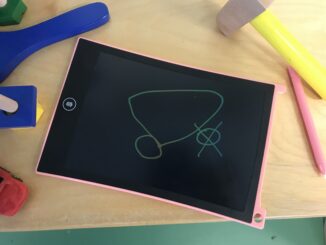My old typewriter has been an option in the room for a few weeks now, but writing feels like a threat to him. Even typing feels adult-dictated. Even typing on something fun.
It always just sits there quietly, an option if he wants to.
He ignores it one week, ignores it again the next. Another week, he expresses wanting to type on it only for the briefest moment — when another student is briefly in my room too, and taps on the typewriter for a couple of seconds, he says, “Hey, it’s my turn on that! I was using that!” As soon as the other student is gone, he’s lost interest.
I start to wonder whether there’s an anxious voice in his head fighting against a desire to try out using it. I remind him that there’s no “right way” or thing he has to type, that he’s welcome to just play around and try to make it make any letters at all, or whatever he wants. Me even having the conversation is too much pressure and he begins insisting he doesn’t want to type. I back all the way off.
Out of nowhere, another session. There’s five minutes left in the session and I let him know. He says, “I need to type something.”
I’m a little worried about it. Rather than getting more regulated, this session has seemed to make him more dysregulated and I’m not quite sure why — I have a few guesses but they could be right or they could be wrong. Either way, I’m a little bit worried because his energy is already quite high, his voice quite loud, his body making big and wild movements. But maybe sitting and typing will help him move it back down? I keep close watch on what he’s doing.
He shoos me away. “You can’t see. It’s a message for you,” he says one second, and then practically one second later is furiously shouting, “how do you put stupid paper in this stupid thing???”
I manage to convince him to let me help load paper. (It had a paper in it, but the paper had a few letters tapped out from somebody else and he wants a blank one.) Then he starts picking away at the letters of the message he wants to send. He’s not hitting the keys with enough force for them to actually leave a mark. “It’s OK to tap it hard,” I tell him, still caught between giving him enough space to not feel watched yet staying close enough to intervene if things go south very quickly. He growls, “Maybe I’ll just punch it like THIS,” and mimes punching all the keys, and gives me a little half-smile to see how I react.
I give him a little half-smile back. “Please don’t punch it. It’s OK if you want to do something else. We don’t have to type.”
“I’m writing a message,” he says with a sigh and turns his focus back to the typewriter. Again…something just doesn’t quite work the way he wants to. With a half-sob he yells “The S is just writing on top of the E!!! It’s not going!!!”
“Is it not moving to the side? It’s very old. Sometimes it gets stuck. It’s not your fault. I can help,” I say. I’m noticing how hard I’m working to convey a lot of information, in short sentences, without sounding like I’m losing my composure. It’s hard work to try to communicate to someone who’s escalating without joining in with their energy.
“…no, it did move,” he mutters, almost to himself. Then silence for a few seconds.
Then— triumph.
“I DID IT,” he yells, jumping to his feet and pointing at the message typed on the typewriter for me. “Put it in your office so you’ll always remember today. It was the best day ever.”




